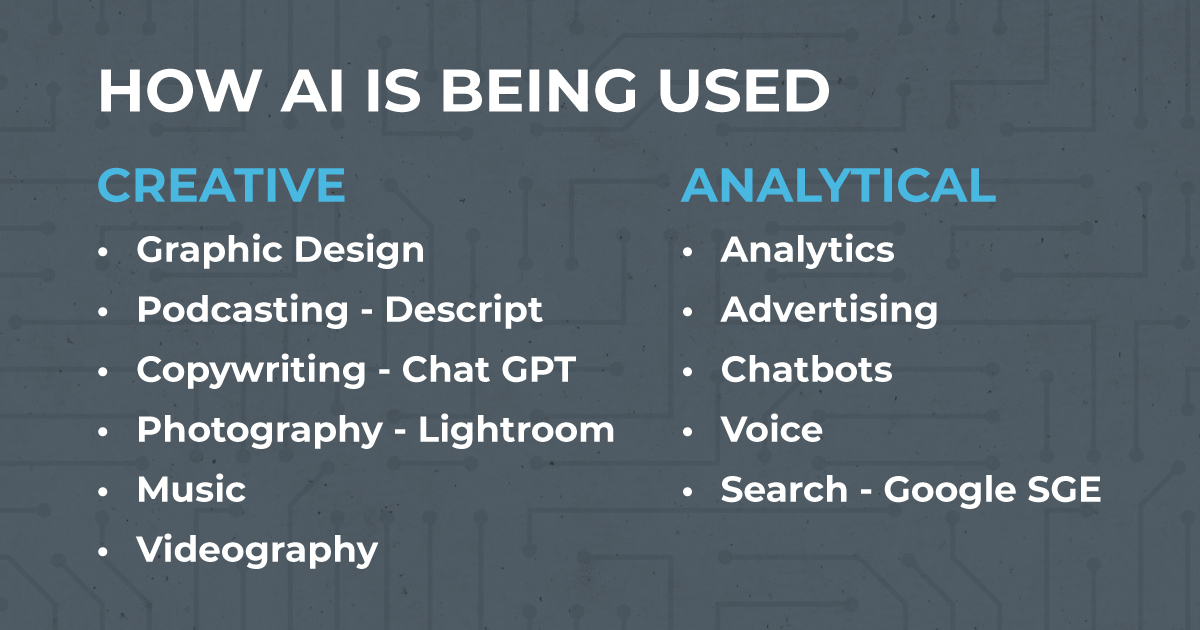AI: Pairs Well With Integrity
03.14.24 · Greteman Group
Unless you’ve had your head in the sand for the last 18 months, you are quite aware that newly-developed AI tools have taken the world by storm. Need to get out of a creative funk? Experiencing debilitating writer’s block? From image creation to generating your next presentation outline, anything is possible by the execution of a simple prompt.
As it’s already being consistently adopted by the masses, it’s become quite apparent that utilizing AI for content creation is no doubt a game changer. But how does it all work, and is consistent use of AI tools ethical as a business? Let’s dive in.
The Power of the Prompt
AI tools such as ChatGPT use data gathered from all over the internet to formulate a requested piece of output. A detailed prompt holds all of the power! (Well, not all of the power… we’ll get into that later.)
However, a strong prompt will produce higher-quality results and save countless hours of spinning your wheels. Need a few examples of creative blog topics to help you generate the next quarter’s editorial calendar? Easy! Want 2-3 social media post examples for each of the blog topics that were just produced? No problem! These tools use generative learning processes to finesse results until the user has what they need.
Here are some examples of areas that are currently using AI:

Research. Edit. Repeat.
It’s vital to remember that much of the data that is being produced within these tools only go up to September 2021, meaning they often lack the latest information. So while you can use these results to spark your own productivity, you still need to follow up with research and editing to ensure that your end product is accurate.
Keep in mind that data produced by these tools might also include many forms of bias, so human critical thinking must supersede anything that comes out of an AI tool. It’s imperative to review all output to ensure the end result is bias-free. Prompt. Research. Edit. Repeat.
You’re probably thinking by now, “well I thought using AI was supposed to save time and increase productivity, but you’re telling me now that I still have to do all of this extra work,” and you aren’t wrong. AI is great for sparking new ideas, and in that way it saves time. Time that, in the past, has been spent blankly staring at a screen waiting for ideas to magically appear. We all spend plenty of time editing our own original ideas, so ChatGPT and similar tools help you jump right into the idea-editing phase of creating instead of the idea-generation phase (when needed).
Keep it Ethical
What you put into AI is exactly what you’ll get out of it, meaning that it is imperative to stay mindful of the information you share with these tools. Organizations who use this kind of technology must always be aware of privacy laws and regulations such as GDPR and CCPA. Never include proprietary and/or confidential information when using AI tools.
As for businesses who create and provide content for their clients, it’s only right to stay transparent about how AI is being used in the creation process. For example, if you are using AI to prompt new article ideas for a given client, be sure that they are aware, but also that it can benefit them. Your company is able to push the boundaries of creativity by staying at the forefront of innovation with the inclusion of Advanced AI in your company toolbelt.
Be upfront about how you’re using it, providing them with reasons as to why it benefits them, while also addressing privacy concerns. The AI tools are still just that – tools for humans to use in conjunction with well-thought-out content creation and deployment strategy.
Ultimately, implementing the use of AI into your workflow can result in an influx in efficiency. With that in mind, always do your homework, edit any results to make it your own, and be transparent about how you’re using it. This way, great results are produced, trust stays intact with clients, and in the end everyone wins.
